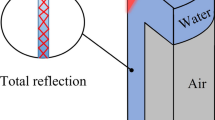Abstract
As five-axis machining technology has been used to eliminate the natural defects, such as taper and jet lag, presented on the AWJ cutting surface, setting the jet rotation control point the same as the jet injecting point simplifies the processing of path planning and trajectory generation greatly. However, to get high precision cutting, the jet injecting point needs to be kept right on the cutting path. There are several major reasons which could cause the jet injecting point deviate from the cutting path, including linear motion errors of the X axis and Y axis, the changing of the standoff distance, and the rotational/swivel errors of the cutting head. In order to keep the jet injecting point right on the cutting path, a standoff distance tracker has been applied to keep the standoff distance unchanged. Further, a method to measure the rotational/swivel errors of the rotational/swivel cutting head and an error compensation method have been provided. To verify the effectiveness of this method, a real cutting has been carried out, and higher precision cutting has been reached.















Similar content being viewed by others
References
Shijin Z, Xiaohong L, Yilei G (2009) Air flow exploration of abrasive feed tube [J]. Acta Mechanica Sinica 25(6):761–768
Chen M, Zhang S, Zeng J, Chen B (2019) Correcting shape error located in cut-in/cut-out region in abrasive water jet cutting process. The International Journal of Advanced Manufacturing Technology 102:1165–1178
Wang M, Hu J, Zan T (2010) Kinematic error separation on five-axis NC machine tool based on telescoping double ball bar [J]. Front. Mech. Eng. China 5(4):431–437
Yin J, Li M, Xu C. (2011). Geometric errors measurement of a large scale five-axis gantry type high speed machine tool. Advances in Automation and Robotics, Vol.1. Springer Berlin Heidelberg, pp.93–99
Hua X, Cheng X, Guohua C, Yu J, Hao Z, Wang Chao, (2019). Measurement and compensation method of rotation angle positioning error of machine tool [J]. Manufacturing Technology & Machine Tool. (09):157-161
Praniewicz M, Kurfess TR, Saldana C. (2019). Error qualification for multi-axis BC-type machine tools [J]. Journal of Manufacturing Systems, 52
Hlaváč LM, Hlaváčová IM, Arleo F, Viganò F, Geryk V (2018) Shape distortion reduction method for abrasive water jet (AWJ) cutting. Precision Engineering 53:194–202
Dumbhare Parikshit A., Dubey Shikha, Deshpande Yogesh V., Andhare Atul B., Barve Purushottam S.(2018), Modelling and multi-objective optimization of surface roughness and kerf taper angle in abrasive water jet machining of steel, Journal Of The Brazilian Society Of Mechanical Sciences And Engineering, vol.40, UNSP 259.
Bilbao GA, Axinte D, Billingham J (2015) The linear inverse problem in energy beam processing with an application to abrasive waterjet machining. International Journal Of Machine Tools & Manufacture 99:34–42
Kwak J-S, Ha M-K (2004) Effects of traverse speed on dimensional error in abrasive water-jet. Journal of Manufacturing Engineering & Technology 13(3):1–8
Ming C, Shijin Z, Jiyue Z, Binghai C, Xue J, Lidanyang J (2019) Correcting shape error on external corners caused by the cut-in/cut-out process in abrasive water jet cutting. The International Journal of Advanced Manufacturing Technology 103(1-4):849–859
Wang S, Shijin Z, Wu Y, Yang F (2017) A key parameter to characterize the kerf profile error generated by abrasive water-jet. The International Journal of Advanced Manufacturing Technology 90:1265–1275
Wang S, Shijin Z, Wu Y (2011) Exploring kerf cut by abrasive waterjet. The International Journal of Advanced Manufacturing Technology 93:2013–2020
Paifeng W, Yuyong L, Liangbo D, Wang R (2011) Study on improving water jet machining quality by applying error compensation technology [J]. Mechinery Design & Manufacture 06:243–245
Zhang S, Chen B, Wu Y, Chen M (2019) Kinematic error compensation of a double swivel head in five-axis abrasive water jet machine tool [J]. The International Journal of Advanced Manufacturing Technology 103(5-8):2783–2793
Geng Pengfei, (2012). Research of high pressure water jet cutting process parameters [D], Yanshan University.
Funding
This paper is sponsored by the National Natural Science Foundation of China (51675320), the Scientific Research Fund of Sichuan Provincial Education Department (Grant No: 182495), and the Key Subject Project (Z171140303) financed by Xihua University, China.
Author information
Authors and Affiliations
Corresponding author
Additional information
Publisher’s note
Springer Nature remains neutral with regard to jurisdictional claims in published maps and institutional affiliations.
Rights and permissions
About this article
Cite this article
Wu, Y., Zhang, S., Lei, Y. et al. Keeping the actual jet rotation control point of AWJ cutting head right on the cutting path. Int J Adv Manuf Technol 108, 3291–3299 (2020). https://doi.org/10.1007/s00170-020-05419-2
Received:
Accepted:
Published:
Issue Date:
DOI: https://doi.org/10.1007/s00170-020-05419-2




